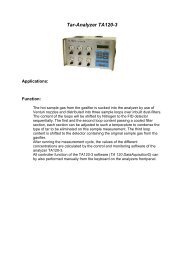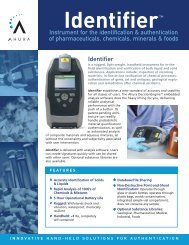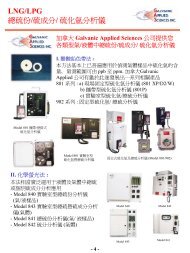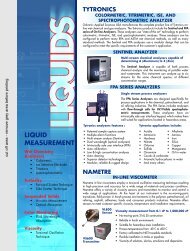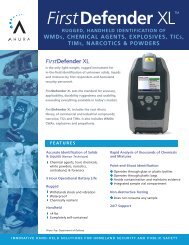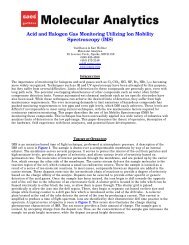PPB Level Process Monitoring by Ion Mobility Spectroscopy (IMS)
PPB Level Process Monitoring by Ion Mobility Spectroscopy (IMS)
PPB Level Process Monitoring by Ion Mobility Spectroscopy (IMS)
You also want an ePaper? Increase the reach of your titles
YUMPU automatically turns print PDFs into web optimized ePapers that Google loves.
<strong>PPB</strong> <strong>Level</strong> <strong>Process</strong> <strong>Monitoring</strong> <strong>by</strong> <strong>Ion</strong> <strong>Mobility</strong><br />
<strong>Spectroscopy</strong> (<strong>IMS</strong>)<br />
Tad Bacon & Kurt Webber<br />
Molecular Analytics<br />
14550-A York Road, Sparks, MD 21152<br />
(800) 635-4598<br />
(410) 472-7300<br />
info@ionpro.com<br />
www.ionpro.com<br />
ABSTRACT<br />
Requirements for high purity products, and the need to monitor for catalyst poisons have driven<br />
the need for process monitoring to the low ppb range. Traditional on-line process analyzers such<br />
as GC, IR, etc. often cannot provide the required sensitivity. This paper describes the use of <strong>IMS</strong><br />
for real time continuous process monitoring. This technique has been field proven to provide<br />
dependable, specific, low maintenance performance in even the harshest environments. Limits of<br />
detection of 1 ppb and below are routinely achieved. Typical applications include: ammonia in<br />
ethylene, hydrogen and other light hydrocarbons; HCl in vinyl chloride and other<br />
chlorofluorocarbons; HF in vinyl fluoride, 134A and other chlorofluorocarbons, Cl2 in hydrogen<br />
and others. This technique has also been successfully applied to ambient air and stack<br />
monitoring.<br />
THEORY OF OPERATION<br />
<strong>IMS</strong> is an ionization-based time of flight technique, performed at atmospheric pressure. A<br />
description of the <strong>IMS</strong> cell is seen in Figure 1. The sample is drawn over a semi permeable<br />
membrane <strong>by</strong> way of an internal eductor. The membrane serves several purposes. It serves to<br />
protect the interior of the cell from particles and high moisture levels, provides a degree of<br />
selectivity, and allows various levels of sensitivity based on permeation rate. The molecules of<br />
interest permeate through the membrane, and are picked up <strong>by</strong> the carrier flow, which sweeps<br />
the other side of the membrane. The carrier stream delivers the sample molecules to the reaction<br />
region of the cell, which contains a small Ni 63<br />
radioactive source. There the sample is ionized as<br />
a result of a series of ion-molecule reactions. In most cases, compounds known as dopants are<br />
added to the carrier stream. These dopants enter into the ion-molecule chain of reactions to<br />
provide a degree of selectivity based on the charge affinity of the analyte. Dopants can be<br />
selected to provide either specific or generic detection of the acid gases. Once the sample has<br />
been ionized, the ions begin to drift towards the opposite end of the cell due to the influence of an<br />
electrostatic field. A shutter grid is located in the tube, which can be biased electrically to either<br />
block the ions, or allow them to pass through. This shutter grid is pulsed periodically to allow the<br />
ions into the drift region. There, they begin to separate out based on their size and shape while<br />
flowing counter to a drift gas flow, which is introduced at the end of the drift tube. A collector<br />
plate located at the end of the tube detects the arrival of the ions <strong>by</strong> producing a current. This<br />
current is amplified to produce a time of flight spectrum. <strong>Ion</strong>s are identified <strong>by</strong> their characteristic<br />
drift time position in the spectrum .A typical series of spectra is seen in Figure 2. This series also<br />
illustrates the charge sharing phenomenon characteristic of <strong>IMS</strong>. The Ni 63<br />
source provides a finite<br />
amount of charge. Accepting charge from the dopant ion ionizes the sample gas. Thus, as the<br />
concentration of the sample gas increases the sample ion peak height increases, while the<br />
dopant ion peak height decreases.
Figure 1 - <strong>IMS</strong> CELL
Figure 2 - - INCREASING CONCENTRATIONS OF HYDROGEN FLUORIDE
HARDWARE<br />
An <strong>IMS</strong> analyzer produced <strong>by</strong> Molecular Analytics is seen in Figure 3. The analyzer consists of<br />
two enclosures joined together. The right hand enclosure is temperature controlled and holds the<br />
pneumatic components of the device including the cell. Carrier and drift flows are provided <strong>by</strong> an<br />
external source of instrument air which is controlled <strong>by</strong> the internal regulator and precision valves.<br />
The scrubbers provide a final cleaning stage for the instrument air. The dopant is introduced into<br />
the carrier stream <strong>by</strong> way of an internal permeation tube. The left hand enclosure contains the<br />
electronic portion of the analyzer. The microprocessor interprets the spectra to identify the<br />
desired component, and determines the concentration based on peak height. The concentration<br />
is displayed on the front of the instrument. Remote indication is provided <strong>by</strong> way of a 4-20 mA<br />
signal loop. Two alarm levels are user settable and are indicated <strong>by</strong> contact closure. The<br />
analyzer also provides on board fault detection, which is indicated <strong>by</strong> a flashing fault code on the<br />
display. Remote indication of fault is indicated <strong>by</strong> contact closure. Most process measurements<br />
are easily made directly, without the need for sample pre-treatment. However, monitoring in the<br />
high temperature and humidity conditions seen in some process streams typically requires the<br />
use of a sampling system. For these measurements, a dilution type probe is most often<br />
indicated. Use of dilution probes is a good match with <strong>IMS</strong> because of the ppb level sensitivity<br />
possible with the technique.<br />
Figure 3 - <strong>IMS</strong> Analyzer
AMMONIA IN VARIOUS PROCESS STREAMS<br />
APPLICATIONS<br />
<strong>PPB</strong> levels of ammonia in ethylene, hydrogen, and other light hydrocarbons cause downstream<br />
process problems due to catalyst poisoning and other factors. <strong>IMS</strong> easily performs this<br />
monitoring, with a limit of detection of 1 ppb. The analyzer has been used in a wide variety of<br />
different process streams, without any evidence of interference from any co-existing compounds.<br />
Figure 4 shows a typical spectrum for this analysis.<br />
FIGURE 4- AMMONIA IN ETHYLENE<br />
HCl IN VARIOUS HYDROCABONS, VINYL CHLORIDE, AND VARIOUS<br />
CHLOROFLUOROCARBONS<br />
HCl can also cause problems in a number of processes. Catalyst regeneration in the reformer<br />
process can produce HCl, which is very corrosive to downstream piping. HCl has undesirable<br />
properties in processes involving vinyl chloride. Ultra-pure gasses needed for the semiconductor<br />
industry such as hexafluoroethane must be monitored for HCl contamination. These ppb<br />
measurements have all been addressed <strong>by</strong> <strong>IMS</strong>. Figure 5 shows spectra obtained from various<br />
concentrations of HCl in tetrafluoroethylene.
2% TFE BLANK<br />
20 <strong>PPB</strong> HCl IN 2% TFE<br />
50 <strong>PPB</strong> HCl IN 2% TFE<br />
100 <strong>PPB</strong> HCl IN 2% TFE
4% TFE BLANK<br />
40 <strong>PPB</strong> HCl IN 4% TFE<br />
130 <strong>PPB</strong> HCl IN 4% TFE<br />
200 <strong>PPB</strong> HCl IN 4% TFE<br />
FIGURE 5- HCl IN TETRAFLUOROETHYLENE
HF IN VINYL FLUORIDE, 134A, AND HYDROCARBONS<br />
HF contamination of vinyl fluoride produces similar problems to these seen <strong>by</strong> HCl contamination<br />
of vinyl chloride. The refrigerant 134a must also be monitored for HF to prevent corrosion in air<br />
conditioners and other refrigeration devices. HF contamination of light hydrocarbons resulting<br />
from alkylation processes is also a concern. On-line <strong>IMS</strong> analyzers have been utilized for all of<br />
these applications.<br />
Cl2 IN HYDROGEN AND OTHER PROCESSES<br />
Hydrogen is often produced <strong>by</strong> electrolysis. Chloride compounds in the water present the<br />
possibility of Cl2 contamination. <strong>IMS</strong> has been used to monitor for this problem. <strong>IMS</strong> has also<br />
been used to monitor for Cl2 in other industrial processes including precious metal recovery, TiO2<br />
manufacture, and in corrosion testing.<br />
OTHER APPLICATIONS<br />
<strong>IMS</strong> is not limited to the applications described above. The technique has also been successfully<br />
applied to a number of unique measurements for specific users, and has wide application in other<br />
process as well as environmental measurements.<br />
REFERNCES<br />
1. V. Harris, S. Klamm, J. Flora, Field Evaluation of Hydrogen Fluoride Continuous <strong>Monitoring</strong><br />
Systems for Fugitive Emissions from Primary Aluminum Potrooms, (Draft Report) EPA Contract<br />
No. 68-D2-0165, Midwest Research, September 26, 1995<br />
2. V. Harris, J. Wilner, "Laboratory and Field Evaluation of <strong>Ion</strong> <strong>Mobility</strong> <strong>Spectroscopy</strong> for<br />
Measuring Hydrogen Fluoride Emissions" presented at the AWMA conference in San Antonio,<br />
Tx. 1995.<br />
3. T. Bacon, "Real Time <strong>Monitoring</strong> of Chlorine Dioxide Without Interference from Chlorine",<br />
Pittsburg Conference, New Orleans, 1992, Paper # 326P.<br />
4. G. Gorden, G. Pacey, B. Bubnis, S. Laszewski, J. Gaines, "Safety in the Workplace: Ambient<br />
Chlorine Dioxide Measurements in the Presence of Chlorine", presented at Chemical Oxidation<br />
Fourth International Symposium, Vanderbilt University, Nashville Tenn., 1994<br />
KEYWORDS<br />
Analyzer, <strong>Ion</strong> <strong>Mobility</strong> <strong>Spectroscopy</strong>, Ammonia, Hydrogen Chloride, Hydrogen Fluoride, Chlorine,<br />
<strong>Process</strong> <strong>Monitoring</strong>



